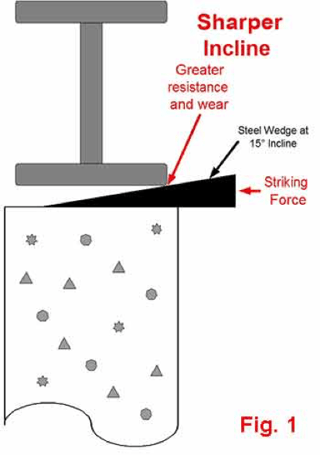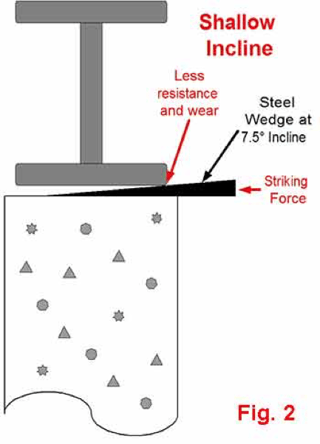Most steel wedges are hard enough to perform a variety of tasks. Our customers are Steel Fabricators, Steel Erectors, Concrete Contractors and a variety of other construction trades. We’ve seen them use steel wedges for everything from leveling staircases to elevating entire structures. Often steel erectors and Concrete Contractors will have them at the jobsites not knowing what they will be used for, but knowing for sure they will be used.
The Steel Supply Company stocks 16 different Steel Wedges and makes custom size wedges to order on a daily basis. For the stock Steel Wedges, not knowing the eventual function usually means producing a medium hard wedge, with a Rockwell of approximately 35 to 40 (Rockwell C). There really is no specific standard hardness that steel wedges are made to. When the intended use is specific, the hardness can be tailored to that need.
For example, a steel “Set-up Wedge” is designed to be used by a machinist to help position a workpiece. In this case the wedge should be soft so it will not damage the workpiece while it is being machined. Interacting with the harden tool steel vices, the workpiece and possibly even the milling tool, the Set-Up Wedge is intended to be the sacrificial component, hence the softer steel. Rockwell C on a Steel Set Up Wedge is 20 to 25.
For driving force our stock wedge # 155–12 x 2 is, as the part number shows 12” long with the large end being 2” x 2” and tapering down to the small end at 1/16” x 2”. (Click here to see the stock wedge listings) A steel wedge this size is most often driven between two surfaces to cause expansion. Because of its size, the installer would usually use a 20 lb. sledge hammer. Struck repeatedly with that amount of force would cause a softer wedge to peen beginning with the first blow. For that reason, this wedge is hardened to a 42 Rockwell C.
On the other hand, it is also important to consider that as the wedge gets harder, it becomes more brittle. Especially when being driven with the force described above, this can create fissures in the steel and dangerous chips which could strike the installer. So keeping hardness in the proper balance is important and obviously whenever striking any wedge wear eye protection.
Whether stock or made to order steel wedges are often purchased for a specific purpose on an individual project. They often get used only once, and when they have fulfilled their purpose may be left in the structure not for any function but simply because removing them is too time consuming and expense. In situations like these the hardness of the steel wedge is less critical in that they are intended as one time use tools.
If continued reuse is intended, another factor when determining Steel Wedge hardness is the incline of the wedge vs. the weight or resistance of the object it will be lifting or separating. As shown in the drawings below, the steeper angle (Fig. 1) will create greater resistance and hence the wedge will wear more. The Shallow angle (Fig. 2) will create less resistance, show less wear and be driven with greater ease.


As mentioned above, stock wedges are made to generic hardness. Made-to-order Steel Wedges can be hardened to accommodate need. The most typical hardening system is to “Case Harden” the steel. This process involves heating the outer surface (the “case”) very rapidly then cooling very quickly. The result is a hard surface while the core of the wedge remains soft. This is desirable because if the steel were hardened completely through it would be much more brittle and subject to cracking.





